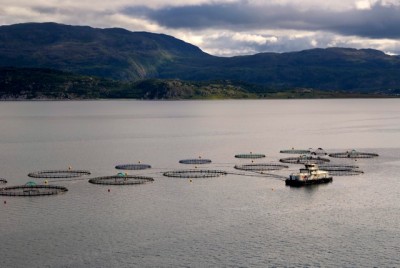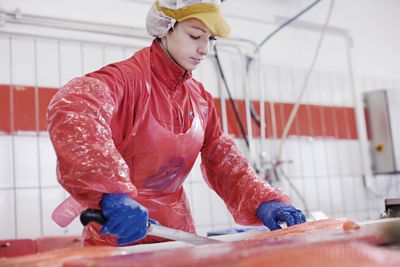Dozens of Norwegian communities in coastal and rural areas are becoming increasingly dependent on immigrant labour as more and more local youth flock to the cities. Fish farming and agriculture can’t find enough workers within Norway alone, while small towns with plummeting populations are being kept alive by immigrants. Meanwhile, many young Norwegians have been criticized for spurning industrial jobs and taking welfare handouts instead.

The “salmon municipalities” with the highest percentage increase in European labour between 2009 and 2013 include Herøy (617.4%) and Sørfold (361.5%) in Nordland, Osen in Sør-Trøndelag (350%) and Gulen in Sogn and Fjordane (326.5%). Roan in Sør-Trøndelag (283.3%) just pipped Herøy in Møre and Romsdal (283.2%) for fifth place, newspaper Fiskeribladetfiskaren has reported.
Despite the major increase in labour immigration, many communities are still struggling to survive. Herøy in Nordland saw the biggest increase in foreign workers over the four-year period, with 142 new Europeans arriving. Yet the town’s population only increased overall by 107. It’s one of many areas being propped up by foreign immigration while the number of local inhabitants drops.
“Labour migration is crucial for the development of our businesses,” said Arnt Frode Jensen, mayor of Herøy. “Generally, we have insufficient labour in many industries, both private and public. We need labour migration.”
Austevoll in Hordaland saw a 276.5 percent increase in European labour migration from 2009 – 2013. “They choose Austevoll because we have work for them, and we need them,” said former mayor Helge André Njåstad, who has now been elected to the Norwegian Parliament. His sentiments come despite the fact Njåstad represents the Progress Party (Fremskrittspartiet), which stands for restrictive immigration.
A review of population figures in salmon farming municipalities shows that without the incoming workers (mainly from Sweden, Poland, the Baltics, Spain and Greece), the salmon industry would have huge problems finding enough labour to keep businesses going.
Competition to attract workers
Fisheries and livestock industries are competing to lure workers to their areas, Fiskeribladetfiskaren reported. Salmon company Salmar has attracted 330 workers from 21 different countries to the Sør-Trøndelag island of Frøya. “We aim to attract people who want to come here for work,” said Salmar’s Vidar Oskarson. “More than 70 percent of production staff at our factory have an immigrant background.”

Workers who don’t speak Norwegian get a specialized language course, which covers basic factory language, safety, hygiene, work practices and social behaviour. “The course is a part of the training and gives an introduction to the Norwegian workplace,” Oskarson explained. “We think the course contributes to our staff establishing themselves on Frøya. About 50 people who have gone through our course have bought houses and settled down on Frøya. Even more plan to buy houses.”
Steigen in Nordland has a population of 2,865 and is dependent on agriculture, aquaculture and fishing. The salmon spawning industry has built up to become a stable industry, contributing millions of kroner in taxes to the rural municipality. NOK 1,100 (USD 180) per person is then invested back into support for businesses.
“If we want to assert ourselves in competition with other municipalities and regions, we have to facilitate industry players,” said Per Løken, Steigen council’s business manager. Successfully attracting large aquaculture companies has flowed onto indirect job creation, in shops, service stations, workshops and other businesses.
Housing shortages
An influx of immigrants creates practical challenges for many townships. Næroy in Namdalen, Nord-Trøndelag is one municipality grappling with housing shortages. “Some work here for shorter periods, while others choose to settle down here,” said Mayor Steinar Aspli. “Population growth means we have a lack of housing in the area, a challenge we’re working to find a solution to.”
While housing and integration of foreign workers can be difficult for the fishery, agriculture and boat-building community, Aspli has argued the benefits outweigh the downsides. “Labour immigration is very important in outer Namdalen,” he said. “It secures primary, secondary and tertiary industries’ workforces for the jobs which are in the municipality. We have largely seen only positive experiences with immigrants. They are people willing to work.”
Lazy youth
While immigrants may be willing to work, the same can’t be said for the youth in many rural areas. “The youth are the most important resource for us in Steigen,” business manager Løken told Fiskeribladetfiskaren. But Mikal Steffensen, the head of Norway’s biggest fishing organization Øksnes Fiskarlag, says youth today are lazy and would rather take welfare handouts than seize opportunities in the fishing industry.
“Many complain that it is so difficult to get into the fishing industry, and that you need so much capital to buy boats and fishing licences,” noted Steffensen. “The truth is that it has never been simpler to get into the industry than today.” Steffensen said most fisheries are open, quotas are increasing, and the banks are willing to back anyone financially responsible. “I believe the youth today whine and complain and would rather go to the state welfare agency NAV than take a chance.”
newsinenglish.no/Emily Woodgate

